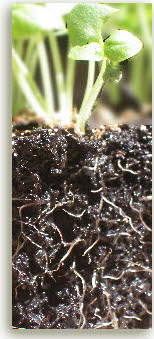Benefits of Bio-agriculture
Carbon Sequestration
 In more than 30 long range farm trials held in Australia, the US and Europe, carbon sequestration rates varied between 0.2 tonnes - 3.0 tonnes carbon per hectare/ year which equals 0.7 tonnes - 11.0 tonnes CO2 equivalent per hectare/year (CO2-e). The amount of carbon sequestered depends on farming methods, soil type, climate and crop varieties. In comparative tests, organic systems accumulated a 12% increase in soil carbon and biodynamic systems accumulated a 16% increase. Increasing carbon sequestration is dependent on continuous bio-agricultural processes. if after sequestering carbon into the soil, we were to return to current conventional farming methods the carbon would gradually be released back into the atmosphere. In more than 30 long range farm trials held in Australia, the US and Europe, carbon sequestration rates varied between 0.2 tonnes - 3.0 tonnes carbon per hectare/ year which equals 0.7 tonnes - 11.0 tonnes CO2 equivalent per hectare/year (CO2-e). The amount of carbon sequestered depends on farming methods, soil type, climate and crop varieties. In comparative tests, organic systems accumulated a 12% increase in soil carbon and biodynamic systems accumulated a 16% increase. Increasing carbon sequestration is dependent on continuous bio-agricultural processes. if after sequestering carbon into the soil, we were to return to current conventional farming methods the carbon would gradually be released back into the atmosphere.
Chemical based farming reduces soil carbon.
Over the long term conventional chemical based farming has been shown to decrease soil carbon. In research by the Rodale Institute it was found that "the application of soluble nitrogen fertilizers stimulates more rapid and complete decay of organic matter, sending carbon into the atmosphere instead of retaining it in the soil as the organic systems do."
Analysis of the US's oldest continuous cropping test plots in Illinois showed that, contrary to long-held beliefs, nitrogen fertilization does not build up soil organic matter. Some Midwestern soils that in the 1950s were composed of up to 20 percent carbon are now between 1- and 2-percent carbon.
"If roughly 8 percent of the carbon being photosynthesised by the biosphere is retained within the soil and biotic pools, the global carbon budget would be balanced."
How does carbon sequestration work?

Carbon dioxide (a molecule made up of one carbon atom and two oxygen atoms—CO2) is taken out of the atmosphere by plants and converted to organic matter by photosynthesis. The oxygen from the molecule is released back into the air while the carbon becomes part of the plant’s structure. When living organisms (humans, animals, microbes) consume the plant, they release some of the carbon back into the atmosphere as CO2, through respiration while some is transformed to soil organic matter.
Agricultural carbon sequestration uses the crop itself and its relation to the carbon cycle to permanently store carbon in the soil. This is done by usiing bio-agricultural farming methods which return biomass to the soil and enhance the conditions in which the carbon within the plants will be reduced to its elemental nature and stored in a stable state in the deeper root area of the plant.
1 tonne carbon = 3.67 tonnes of CO2-e (CO2-e is the carbon dioxide equivalent of the combination of greenhouse gases.)
Globally, soils are estimated to contain 1,500 gigatons of organic carbon which is three times more than the total of carbon in vegetation and the atmosphere combined.
The Leaking Bucket Analogy
According to Dr Brian Murphy of the NSW Department of Environment and Climate Change:
Soil carbon sequestration means getting more carbon-based life into the earth, in the form of plant fragments and the tiny organisms that break them down. The problem is that microbes break down plant matter and return it to the air at the same rate as it is buried in the soil.
Dr Murphy uses the analogy of a leaking bucket to explain the cycle, saying no matter how much water you put in, the same amount will leak out again. Changed land management practices can result in soils having more plant matter and nutrients. The leaky bucket is then replaced with a bigger bucket; it would still leak at the same rate but it would hold more (carbon) at any one time.
This is why carbon sequestration is a short term solution to climate change. Once ‘the bucket’ has reached its largest volume then its capacity for storing more carbon will be minimal. If farming is stopped at this or any other stage, then the carbon in the soil will be gradually released back into the atmosphere.
This bucket analogy highlights some of the questions about biosequestration as a long range solution for soil-carbon storage. Research shows that continuous bio-agricultural farming can store measurable increasing yearly rates of soil-carbon for up to 40 years. The additional benefits of water saving, land regeneration, pollution reduction, healthy food and savings on fertiliser costs provide enough incentive to keep using these farming methods even when the soil has reached its fullest carbon storage capacity.
|
